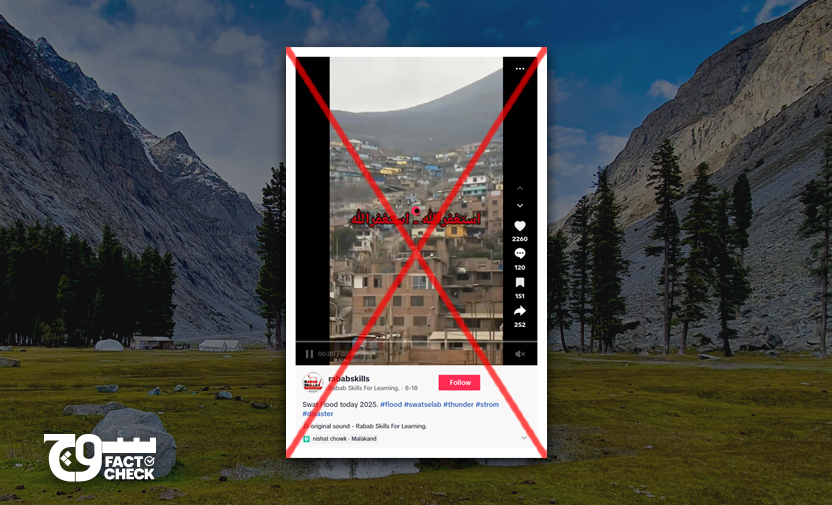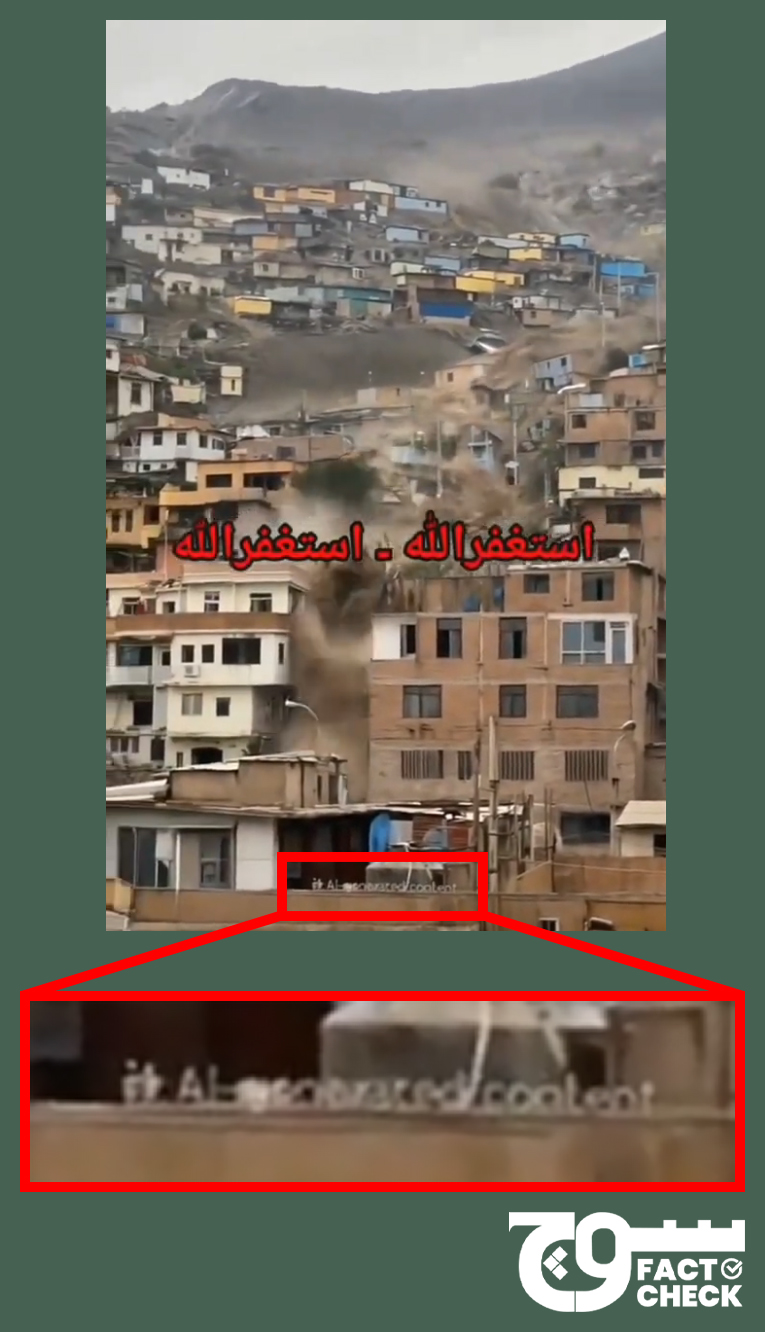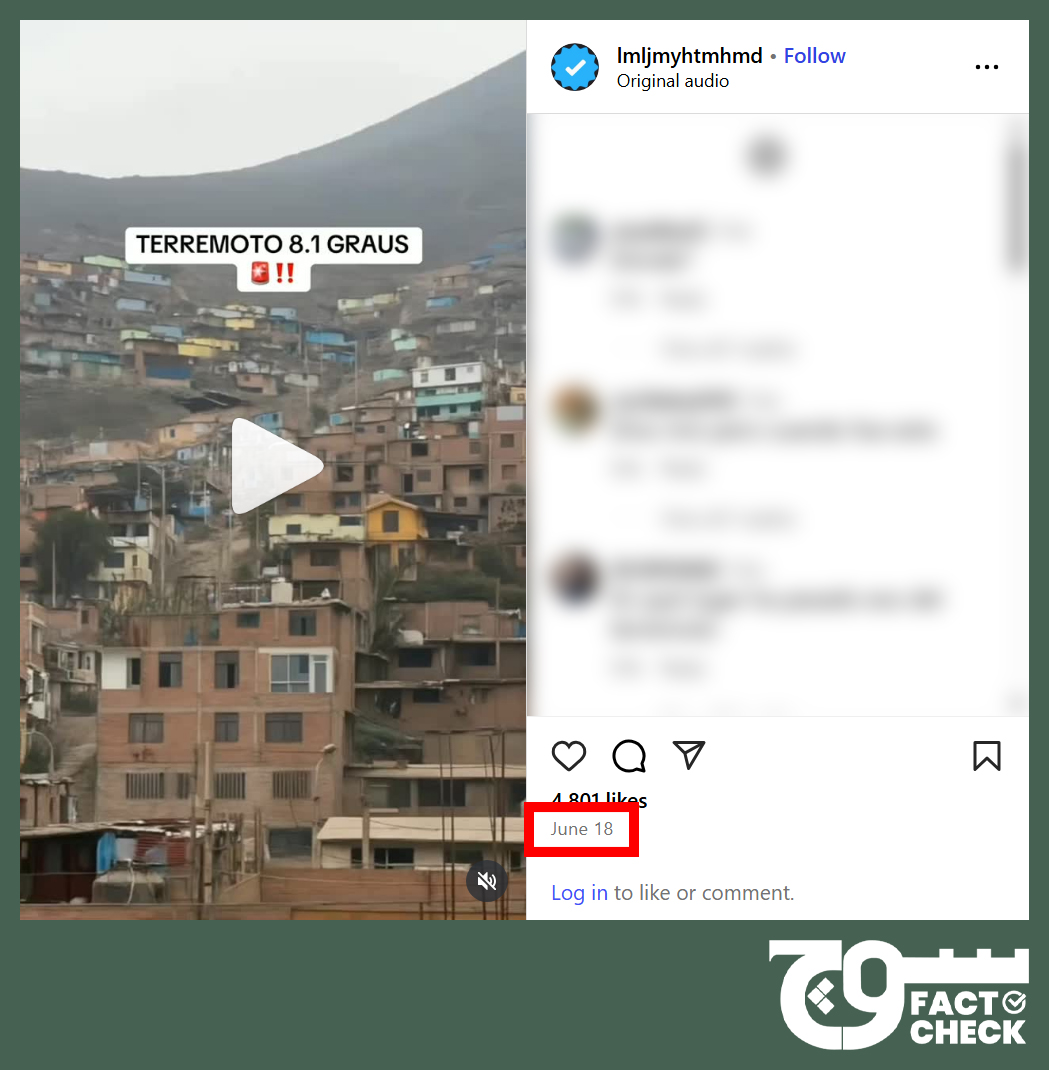
Claim: A clip shows the exact moment a flash flood hit a mountain-side village in Swat and destroyed multiple houses in August 2025.
Fact: The clip is synthetically generated, likely using AI tools.
On 18 August 2025, TikTok user @rababskills posted (archive) a video they claimed shows floodwater thundering down a mountain in Swat before it crashes into a village and destroys a number of buildings. The clip surfaced amid stormy weather as torrential rains and urban floods wrought havoc in multiple cities across Pakistan, especially in areas within Khyber Pakhtunkhwa.
@rababskills captioned the video as: “Swat Flood today 2025.”
According to a daily situation report issued by the National Disaster Management Authority (NDMA) for the 2025 monsoon season, one person was killed in Swat, 170 houses damaged, and 163 livestock perished on 17 August.
Hundreds killed in floods
The overall death toll from flash floods in Pakistan was over 1,000 as of 19 September, according to data (archive) compiled by the NDMA, which revealed that more than 500 of these fatalities were in KP.
Additionally, upwards of 1,000 people have been injured, 12,500 houses destroyed, and 6,500 livestock have perished since 6 June, according to the NDMA.
Citing data from KP’s Provincial Disaster Management Authority (PDMA) as of 20 August, ReliefWeb — an information portal by the United Nations (UN) Office for the Coordination of Humanitarian Affairs (OCHA) — said the Buner district was hit hardest with the highest number of people killed at 228 and over 3,800 cattle perished.
Soon after the flash floods in mid-August, at least 89 trucks worth of aid was delivered to affected districts on the orders of KP Chief Minister Ali Amin Gandapur, the provincial government said, adding that the PDMA released PKR 800 million to the affected districts and PKR 500 million to Buner. PKR 1 billion was also provided to the Rescue and Relief Department to support flood affectees.
In a 15 August update, it said, “On the directives of the Khyber Pakhtunkhwa health advisor, a health emergency has been imposed in the flood- and rain-affected districts (Buner, Swat, Mansehra, Bajaur, Mohmand, Abbottabad), flood control rooms established, all medical staff put on high alert, leaves canceled, and treatment [of patients] in hospitals continues uninterrupted.”
“Rescue officials evacuated 2,071 individuals to safe locations,” it added.
The Guardian reported, “The provincial rescue agency told AFP that about 2,000 rescue workers were engaged in recovering bodies from the debris and carrying out relief operations in nine affected districts.”
Residents were caught off guard, with one person telling Al Jazeera that the floodwater “came so fast that many could not leave their homes”.
At a news conference, NDMA Chairperson Lt Gen Inam Haider Malik said weather in Pakistan was changing drastically due to climate change, Al Jazeera reported, quoting him as saying, “The intensity of this year’s monsoon is around 50 to 60 percent more than last year.”
“Climate change has directly amplified the triggers of cloudbursts in Pakistan, especially. Every 1°C rise allows the air to hold about 7% more moisture, increasing the potential for heavy rainfall in short bursts,” ABC News said, quoting experts.
The situation is made worse because of the unexpectedness of this phenomenon, with Pakistani officials saying “a warning to allow evacuations was not possible, as the cloudburst struck before residents could be alerted”, ITV reported.
Fact or Fiction?
Soch Fact Check analysed the video and found inconsistencies that are in line with content generated using artificial intelligence (AI) tools.
Firstly, the large volume of water shown in the video should have caused more destruction but only a few structures move or wobble a little. Many buildings appear to dissolve, instead of crumbling, after the flood hits them whereas others just remain standing despite being struck by the apparent strong flow.
At one point, water splashes out from under some structures on the top-left but without destroying them, as they would in an authentic situation when the ground gives way.
Additionally, when observing the white building that appears at the bottom-left in the latter half of the video, we noted that too much water splashes out of its roof as compared to the wave travelling downwards from above.
Lastly, the words “AI-generated content” appear on the bottom-right in white on top of the wall surrounding the roof of a peachy-coloured house.

Reverse-searching keyframes from the video led us to a 26 June 2025 post, containing a horizontally-flipped version of the same clip.
We also came across an 18 June 2025 post that starts with the same shot but shows a giant chunk of land falling over and completely destroying the village. The words “TERREMOTO 8.1 GRAUS,” or “EARTHQUAKE 8.1 DEGREES,” are superimposed on the clip.

This indicates that both videos were created using the same source content — a static image or brief footage — shown at the very start. It is unclear when the original first surfaced online or whether it showed something else entirely.
Soch Fact Check also ran the video through DeepFake-O-Meter, an AI detection tool developed by the University at Buffalo’s Media Forensics Lab (UB MDFL). Of the available detectors, we used AVSRDD and WAV2LIP-STA; the results showed that the probability that the clip was created synthetically is 100% and 40%, respectively.
Virality
Soch Fact Check found the clip posted here, here, here, and here on TikTok, here, here, and here on YouTube, and here on X (formerly Twitter).
It was also shared here, here, and here on Facebook, here, here, and here on Instagram, and here on Threads.
Conclusion: The clip is synthetically generated, likely using AI tools.
Background image in cover photo: Asi Abbasi
To appeal against our fact-check, please send an email to appeals@sochfactcheck.com
